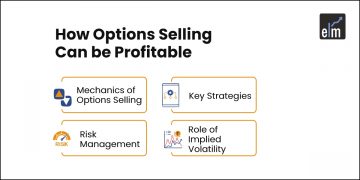A call ratio back spread strategy is a bullish options trading strategy that entails purchasing and selling call options. The strategy is intended to profit as much as possible from a significant increase in the price of the underlying stock in the near term.
The combination of options purchased and sold reduces your risk while providing theoretically unlimited profit potential.
So, in today’s blog, let us discuss Options Trading with Call Ratio Back Spread Strategy:
What is Call Ratio Back Spread Strategy?-Call Spreads Explained
A call ratio backspread is an options spreading strategy used by bullish investors to limit losses while expecting the underlying security or stock to rise significantly.
The strategy combines buying a larger number of call options with selling a smaller number of calls at a different strike but with the same expiration date.
While the downside is protected, gains can be substantial if the underlying security rises significantly due to the ratio feature.
Now, let us discuss how the Call Ratio Back Spread Options Strategy works:
How does Call Ratio Back Spread Options Strategy work?
Let us discuss how to implement the Call Ratio Back Spread Options Strategy:
1. Outlook
The strategy is used when one is extremely bullish on a stock (or index), as opposed to the bull call spread or bull put spread, which is used when one is moderately bullish.
2. Strategy
The Call Ratio Back Spread is a three-leg option strategy in which two OTM call options are purchased, and one ITM call option is sold. This is the traditional 2:1 ratio. The call ratio back spread must be executed in a 2:1 ratio, meaning that two options must be purchased for everyone option sold, four options must be purchased for every two options sold, and so on.
Assume the Nifty Spot is at 16050, and you expect it to reach 16200 by expiry. This indicates a bullish market outlook. To use the Call Ratio Back Spread.
- Sell one lot of Nifty 50 CE (ITM)
- Buy two lots of Nifty 50 CE (OTM)
Make sure –
- The Call options belong to the same expiry
- It belongs to the same underlying
- The ratio is maintained
3. Maximum loss\risk
The maximum potential loss occurs if the underlying stock price is at the higher strike price of the two calls purchased when the options expire.
At that point, the maximum loss will equal the difference between the bought and sold call strike prices, less the net credit received when establishing the position or the net debit incurred when establishing the position.
Thus the maximum loss is limited to Spread – Net Credit
You can also read our blog on 12 Common Option Trading Strategies Every Trader Should Know
4. Profit
Because the strategy involves the purchase of two call options, the potential profit from a rise in the underlying stock price is theoretically unlimited.
If you can establish this call spread position for a net credit, you can profit even if the underlying stock price falls rather than rises.
If the stock price at the time all options expire is less than the strike price of the call option that was sold, all options will expire worthless, but you will keep the credit received when the position was established.
You can also join our course on Advanced Options Strategies
5. Breakeven stock price at expiration
There are two breakeven points:
- Lower Breakeven = Lower Strike + Net Credit
- Upper Breakeven = Higher Strike + Max Loss
6. Payoff Diagram
Below is the payoff diagram of this strategy
You can practice more such strategies in ElearnOptions
Bottomline
We hope you found this blog informative and use it to its maximum potential in the practical world. Also, show some love by sharing this blog with your family and friends and helping us in our mission of spreading financial literacy.
Happy Investing!
You can also visit web.stockedge.com, a unique platform that is 100% focused on research and analytics.










